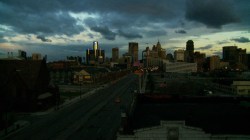
Tony Hardmon
Don’t go see Detropia hoping for ruin porn. The new film by acclaimed documentary filmmakers Heidi Ewing and Rachel Grady (Boys of Baraka, Jesus Camp) gives you more than pretty pictures of abandoned buildings: It gives you the story of the people who live among them.
In one of the first scenes of the film, we meet Crystal Starr, a Detroit videoblogger who trolls these buildings for fun. “What was there? Who was there?” she asks while exploring an old apartment building. “I’m picturing this place clean, and people walking around, and shit happening.” She stops in front of an open window in an apartment kitchen. “Can you imagine having breakfast right here? You know what I mean, like, look at your view.” The Detroit skyline looms in the distance, over a swath of overgrown greenery. “Like ‘Yeah, I’m gonna go out and conquer the world, ’cause I can damn near see it right here.’”
“Our aesthetic approach was definitely Detroit as dreamscape,” Ewing says. “You can drive for several miles and really not see anyone — and it’s not because there’s no one there, it’s because you have 139 square miles with only 700,000 people living there.”

Wolfgang HeldCrystal Starr looks out over an urban dreamscape.
What makes the dreamscape of Detropia so powerful is the fact that it’s rooted in reality. Throughout the film (whose name is a mashup of “Detroit” and “dystopia”), the directors drop a succession of shocking facts: Every 20 minutes, another family moves out of Detroit. In 1930, Detroit was the fastest growing city in America; it is now the fastest shrinking. In the last 10 years, Michigan has lost 50 percent of all its manufacturing jobs. The geographic areas of Boston, San Francisco, and Manhattan can fit within the city limits of Detroit, yet the city itself has fewer people than Fort Worth, Texas.
Ewing and Grady don’t generalize in this film, and, refreshingly, they don’t offer any silver-bullet solutions or tidy endings. Rather, they manage to tell the story of a city through three artfully chosen main characters: Starr, the videoblogger; George MacGregor, a veteran union organizer; and Tommy Stevens, a retired schoolteacher who owns and operates a bar, the Raven Lounge.
With boisterous crowds and sweaty live music, the Raven Lounge acts as the setting for many of the film’s happier scenes, and yet it, too, hints at tragedy. Located across the street from the old Chevrolet plant, much of its success hinged on that of the car companies, and Stevens still holds out hope that energy-efficient cars like the Chevy Volt will bring in enough customers for him to hire more staff (in the film, he cooks all the food himself).

Tony Hardmon
One of the most provocative and heartbreaking moments in Detropia is when Stevens, visiting the North American International Auto Show at Detroit’s convention center with his wife, realizes that China’s electric car, manufactured by BYD, gets more mileage per charge and costs thousands of dollars less than the Volt. “This is still a town where we all think that we’re one excellent car away from a comeback,” Ewing says. “And the numbers just don’t add up.”
The filmmakers avoided the “low-hanging fruit,” Ewing says — the ubiquitous shots of urban chaos that would have eliminated the thin, yet ever-present, line of hope that threads through the film. “There are no homeless people in the film. There are no drug addicts in the film, there are no tent cities in the film; there are no people shooting up or sleeping under trees and trash, which you see all the time in Detroit.”
But nor do they hang their hope on the influx of young (predominantly white, predominantly privileged) artists who have occasionally been unjustly credited as saviors of the city. All three of Detropia’s characters are middle-class, employed African Americans. The artists who get the most screen time are the film’s poster couple: Steve and Dorota Coy, whose noble performance art critiques capitalism and corporate America.
And while Ewing and Grady hint at the possibility of a revival driven by new arrivals (young, white artist buys a loft, comments on how affordable everything in Detroit is as his chrome kitchen appliances gleam in the background), they don’t make any promises, and Ewing recognizes the problems with this narrative. “It’s too early to tell if they’re going to stay,” she says. “The film is so much more about the consequences of short-term thinking on behalf of our industries, our leaders. To throw it all in the hands of these newcomers and hint that that’s absolutely going to be the comeback — that felt too simplistic.”

Craig Atkinson
So who will save the city, then? Ewing points to small businesses. “Dependence on a major corporation, the belief that the corporation is going to take care of a city or a huge amount of people — we have to let go of that idea,” Ewing says. “I think entrepreneurship, small businesses, are the only way.”
Detropia’s message echoes beyond the Motor City, and Ewing hopes Americans across the country can learn from it. “A DIY attitude is crucial. A sense of getting involved in one’s community and not standing on the sidelines is essential,” she says. “Pay attention to our trade policies. Vote with knowledge.”
Detropia premiered at Sundance in January, where it earned the festival’s award for best editing. The film, which Ewing and Grady chose to self-distribute in order to guarantee pre-election screen time, is currently playing in Detroit, New York, Washington, D.C., Chicago, Boston, Providence, and San Francisco, and will open in other cities this month. To find a screening near you, visit detropiathefilm.com.



